I’ve been writing about AI for close to two years now.
As such, it might surprise you that AI hasn’t ever done any actual writing for me.
This isn’t because I am vehemently against AI writing.1
It’s because I enjoy the process of arranging words into sentences. It’s not something I want to outsource.
At the same time, I fully acknowledge that just as I might use an image model to make up for my lack of artistic talent, others might use a large language model to help them write something that might’ve otherwise gone unwritten.
Yet many writers scoff at the very idea of using “AI” and “writing” in the same sentence as I just did.
Listen, I get it.
You care about the story you want to tell, and you want to tell it in your voice. You don’t need AI and its filthy algorithms sucking the soul out of your narrative.
But there are many ways you as a writer can use AI without having it write a single word of the final text on your behalf.
No author is an island.
In the process of writing and publishing your story, you might have a brainstorming partner, a research assistant, an editor, a few beta readers, and a trained monkey named Fizz who brings you piña coladas upon request.
(Hey, I don’t know your life.)
AI can do a decent job in many of those areas.
So let’s look at a few cases where writers can use AI without giving up creative control.2
🔍1. Research
Let’s pretend I want to write about a 16th-century English detective, but my memories of that time are hazy.
(I was minus 500 years old back then. A mere baby.)
I can ask ChatGPT for help:
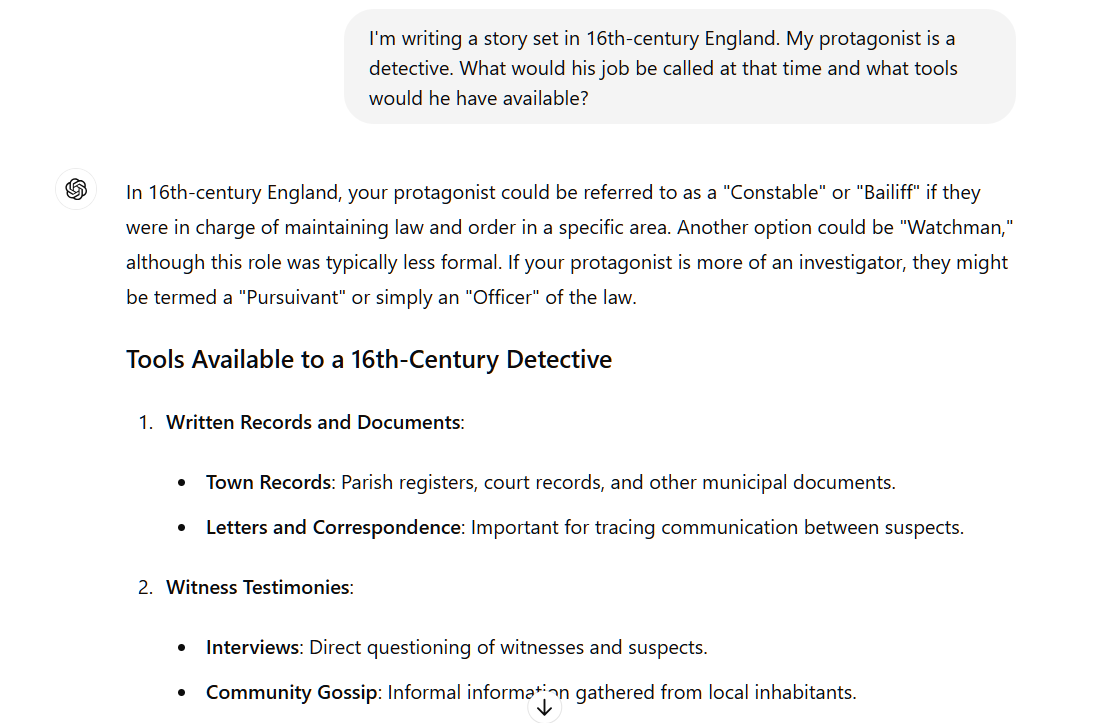
Instantly, I get a wealth of information about possible directions to explore. (See the full chat for details.)
“Daniel, you naive fool! True research takes more effort than skimming a few bullet points from a chatbot.”
I agree, my suspiciously convenient straw man friend.
ChatGPT can’t replace serious research.
But it sure can point you in the right direction.
Taking bullet #5 as my starting point, I dig deeper:
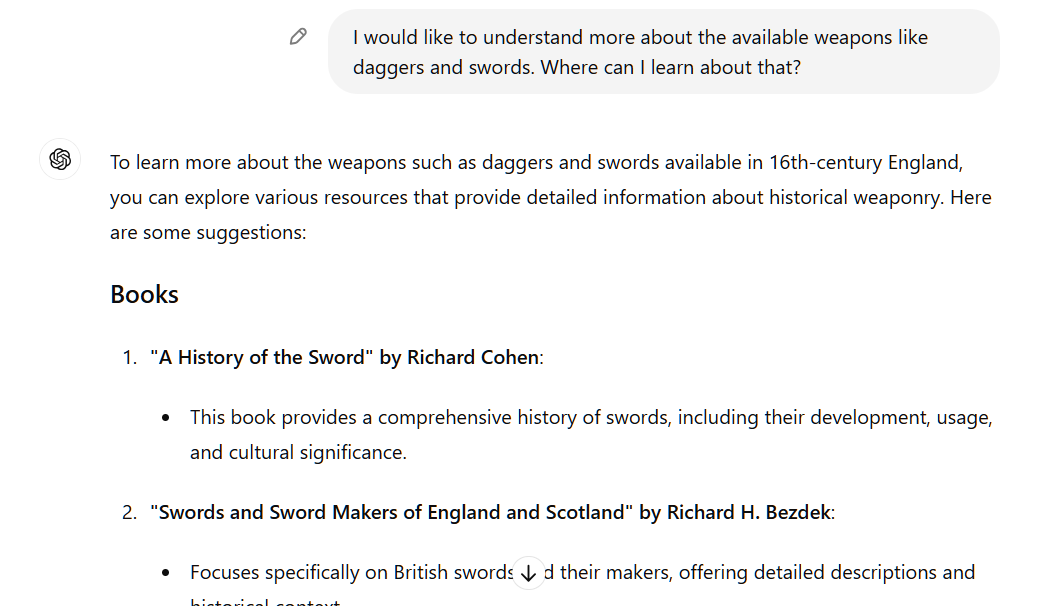
I now have plenty of new research avenues to pursue.
Note: As with anything an LLM spits out, always double-check every fact.3
If I want to stick to online research for now, I can just ask:
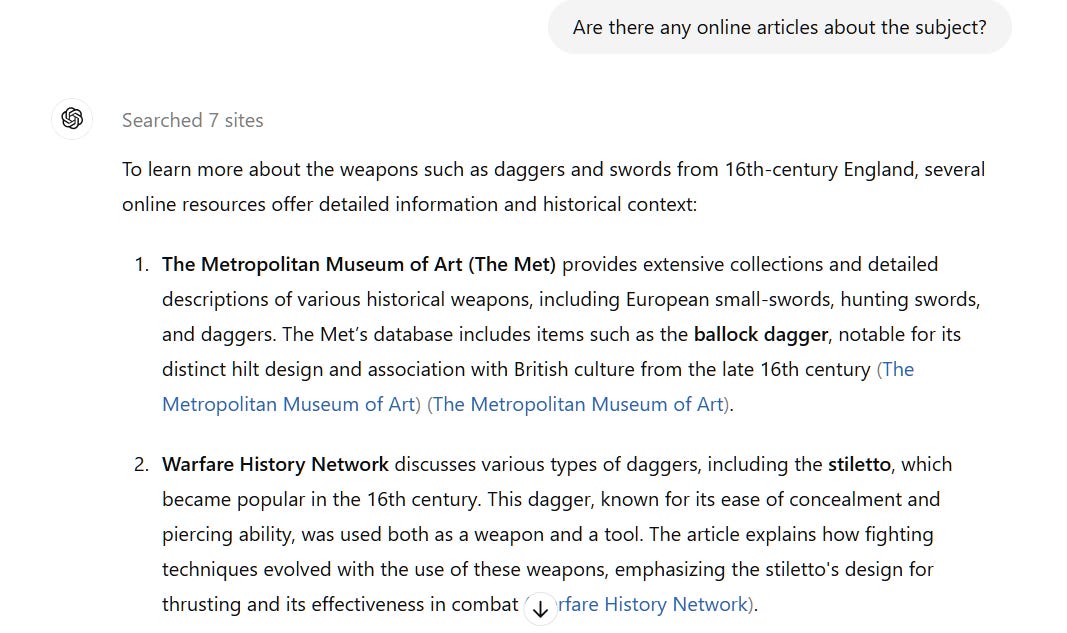
The very first link takes me directly to this page of The Met:
I went from having a vague idea about my protagonist to looking at a visual of the kind of weapon he might’ve carried.
🤯2. Brainstorming
I’ve now decided that my story will involve a ballock knife-wielding constable who ends up stabbing an innocent person. I might have a general idea of where I’m headed, but I could use a sparring partner.
Armed with the “Ask Me Questions” method, I turn to ChatGPT again:
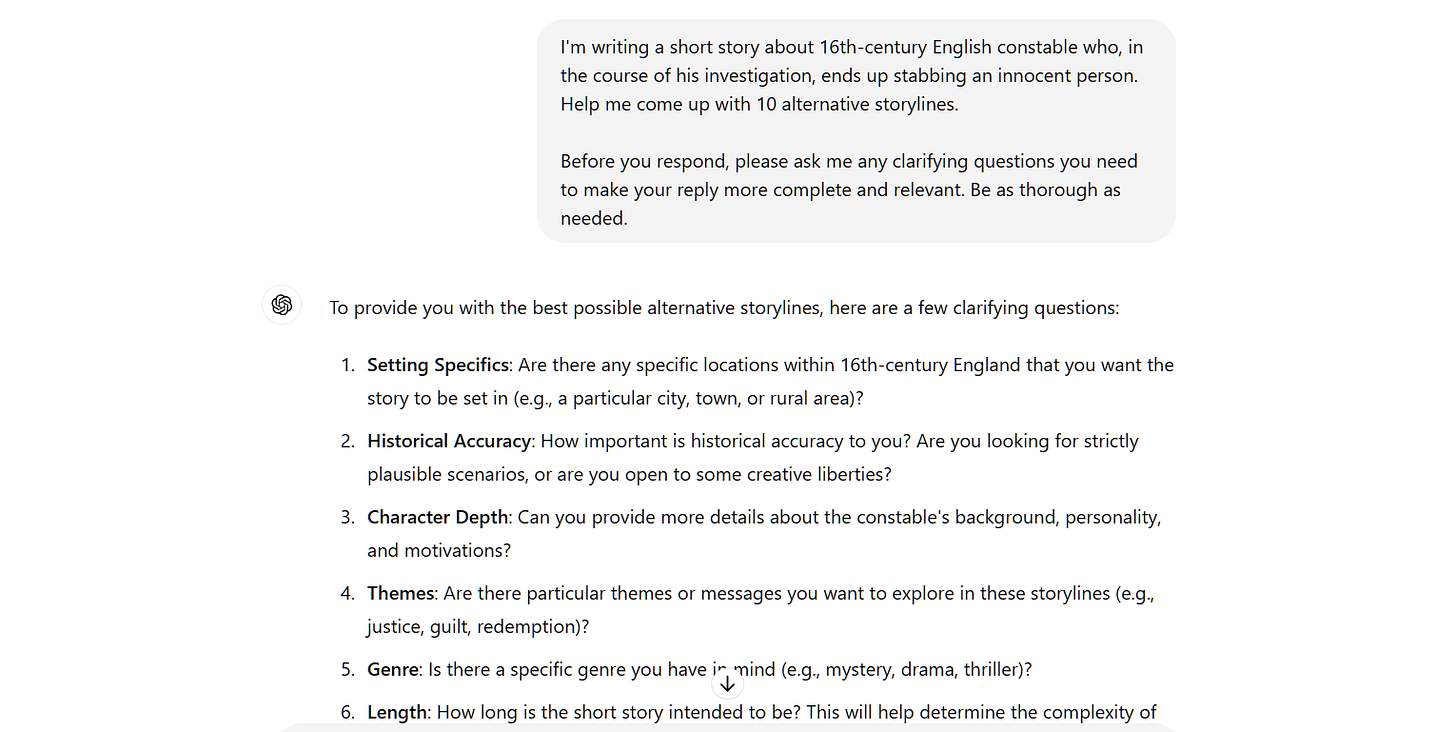
Two great things come out of this exercise:
ChatGPT’s initial questions force me to think about aspects that might not have even been on my radar. Answering them gives me a better understanding of what I’m after.
I get a list of alternative ideas to consider.
There’s no downside to this.
If some of ChatGPT’s ideas are workable, you can continue your brainstorming session to flesh out the details.
If all of them suck, you can either try again or draw whatever inspiration you can from it and move forward on your own.
You’re still in charge of your story and don’t have to accept anything ChatGPT tells you.
📝3. Outlining
When it comes to fiction, I’m what’s apparently called a “pantser.” This means I tend to wing it and make the plot up as I write.
“Plotters,” on the other hand, create an outline and plan out each scene before writing.
Whichever camp you fall into, AI can help.
For plotters, a ChatGPT outline may offer a solid starting point.
For pantsers, ChatGPT is a good way to anchor themselves a bit.
Say I want my stabby constable to eventually decide to cover up his crime and frame someone for it. (Yeah, he’s a shitty guy.)
Let’s ask ChatGPT for a potential outline:
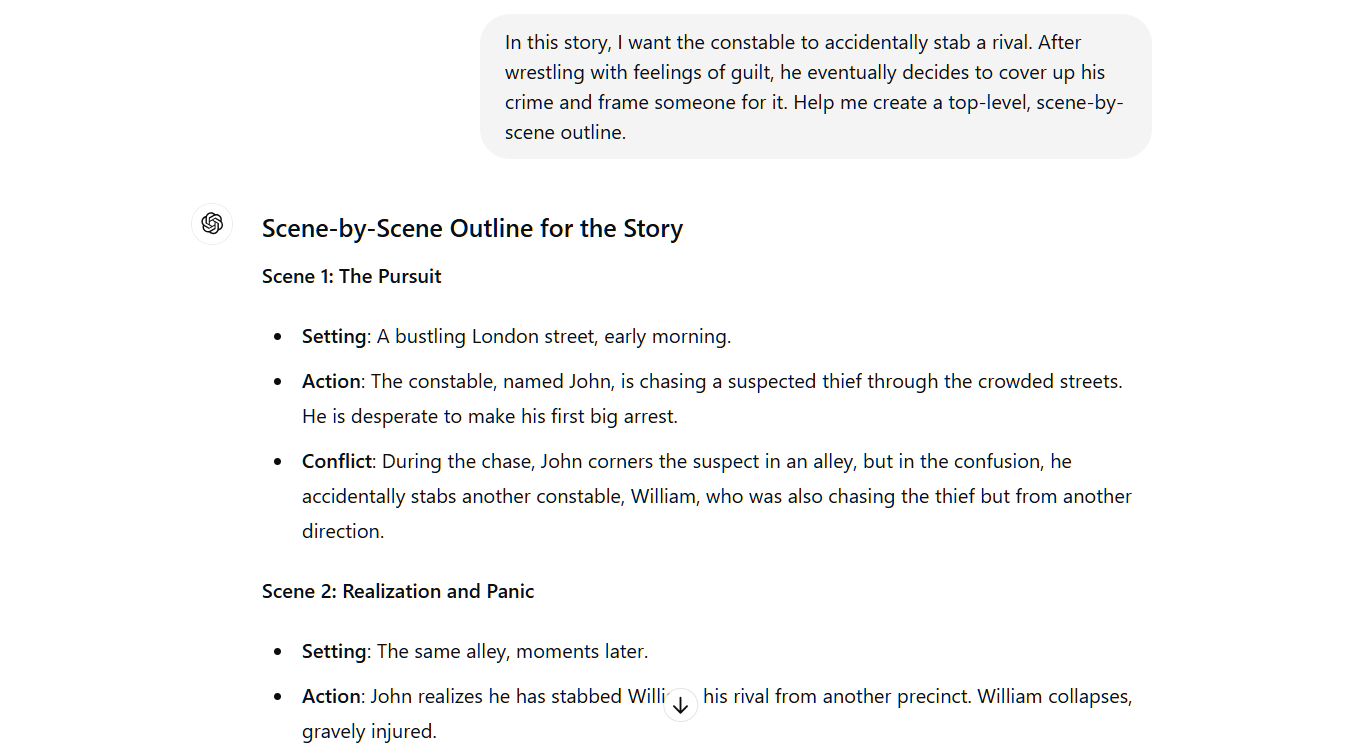
You can keep asking ChatGPT to tweak each scene, change their order, add or replace story beats, etc. to end up with your final outline.
At this point, you’re free to start writing.
🖼️4. Visualizing scenes
Sometimes, it helps to be able to picture your setting vividly.
If I’m writing the scene where my constable stabs another one in a narrow alley, I can ask ChatGPT to create an image for me to go on, like so:
They say a picture is worth a thousand words.
That’s why you can just ask ChatGPT to make 3 images instead of writing a 3,000-word story.
Having a visual in front of you may get your creative juices flowing.
👩🏫5. Beta reader feedback
Once your draft is ready, you’ll want someone to read it and give you an honest opinion.
While AI models can’t replace a diverse group of beta readers, they work great as an extra pair of “eyes” on your work. As a bonus, they read insanely fast and can instantly offer structured and constructive feedback.
As a meta-exercise, let’s ask Google Gemini 1.5. Pro to be my beta reader for this very post. Your prompt can be as simple as:
Please give me feedback as a beta reader for this post:
[YOUR POST]
You might get something like this:
From here, you have the option to zero in on each item of feedback and ask for further suggestions.
🧐6. Editing and proofreading
You might think your grammar is flawless and you never make mistakes.
But even the best writer needs an editor.4
Incidentally, large language models excel at the whole “language” thing.
So why not let them review your work?
You can simply ask ChatGPT to edit or proofread your text, or you can get more specific. This article looks at the different types of editing, which you can ask AI to perform.
The prompt might look like this:
Take a look at this article: [ARTICLE ABOUT TYPES OF EDITS]
Now act as a [TYPE OF EDITOR] and review the following. (Highlight any changes you make in parentheses):
[TEXT TO REVIEW]
Here’s a snapshot of ChatGPT acting as a line editor:
If you’re publishing a substantive piece of work like a research paper or a book, you’ll need a professional editor.
But even in those cases, there’s no harm in using ChatGPT for your first pass.
💡7. Other uses
You can likely find dozens of niche uses for AI in your writing process.
Here are a few:
Identifying plotholes
Keeping track of characters, names, settings, items, etc.
Getting unstuck (e.g. “How do I transition from scene A to scene B?”)
Writing practice (e.g. “Give me a writing prompt” or “Start a story and let me finish it.”)
My main message is: You’re in charge.
You don’t have to accept any of AI’s suggestions, and you retain ultimate control over everything you put down on paper.
AI gives you the option of an immediate, always available second opinion.
It’d be a huge shame not to make use of it.
🫵Over to you…
How do you feel about using AI as a writer’s assistant? In which of the above areas would you personally benefit from AI? Which tasks would you never outsource to AI?
Are there other things AI can help writers with that I didn’t manage to cover? I’d love to hear about your experience!
Leave a comment or shoot me an email at whytryai@gmail.com.
Although one can definitely do better than out-of-the-box ChatGPT. And I am against AI-generated, low-quality spam.
I use ChatGPT for my examples, but you can go with your preferred large language model.
For instance, Richard Cohen doesn’t appear to have written a book called “A History of the Sword,” but he did write one called “By the Sword" which might prove relevant.
I often edit other people’s texts as part of my day job and pride myself on my attention to detail, but I still let some types sneak in or fail to catch obvious arrows.

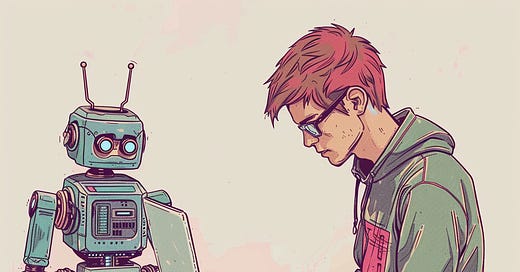



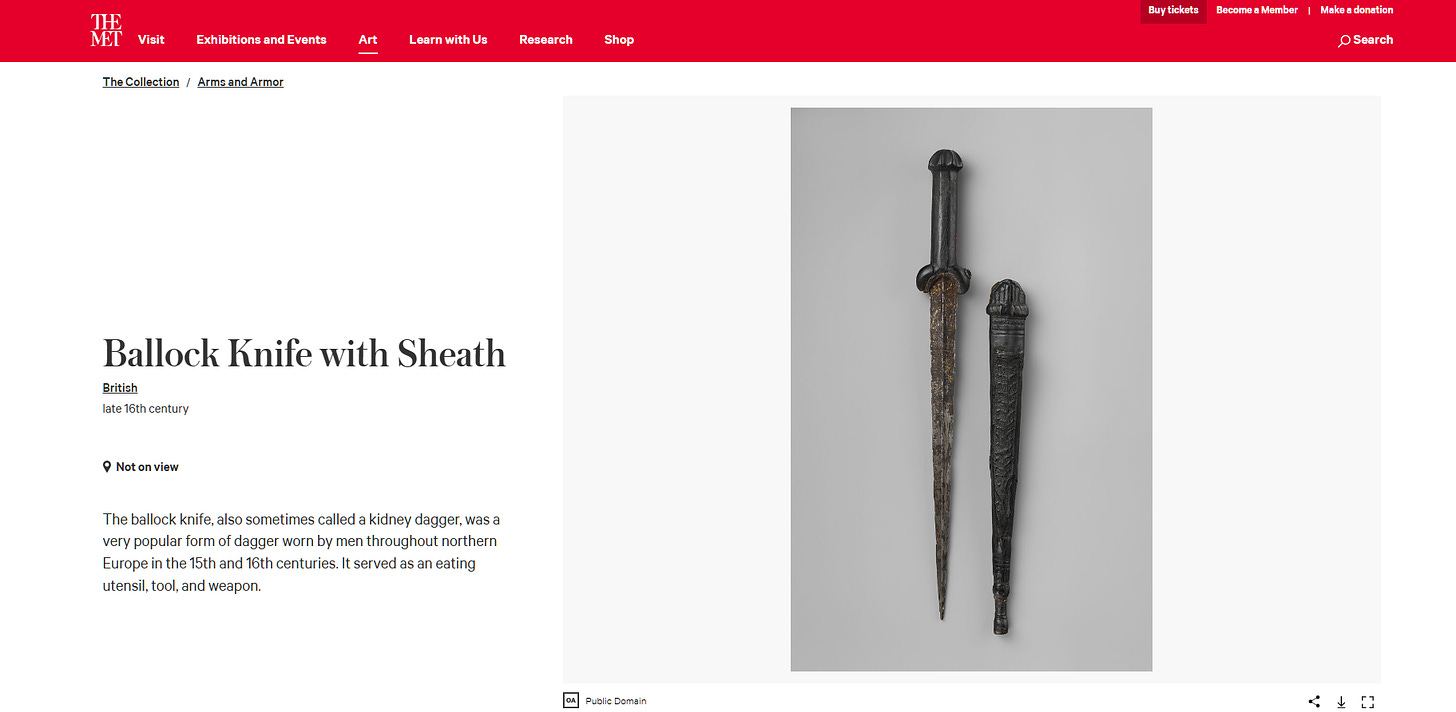
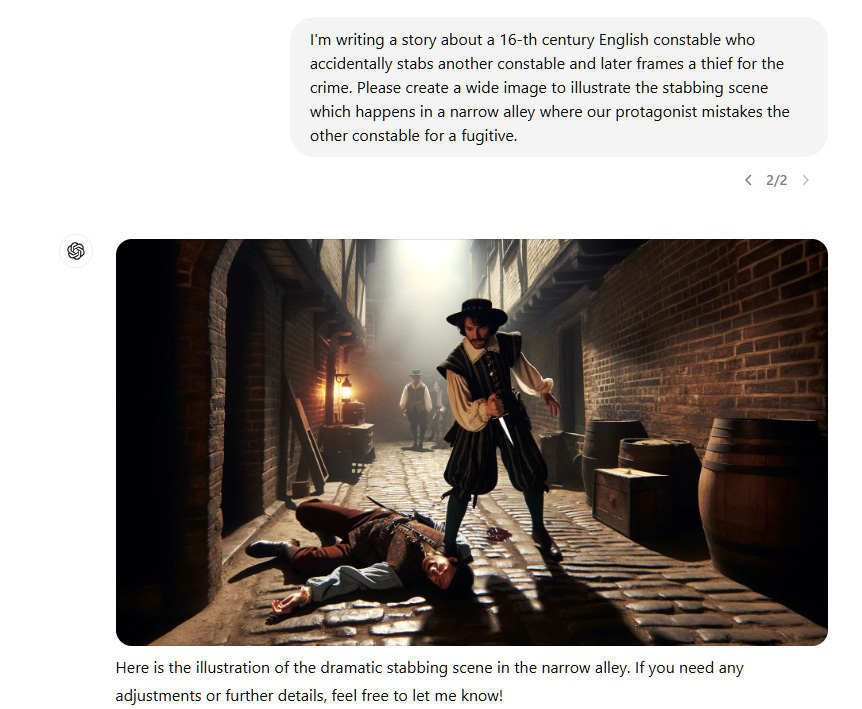
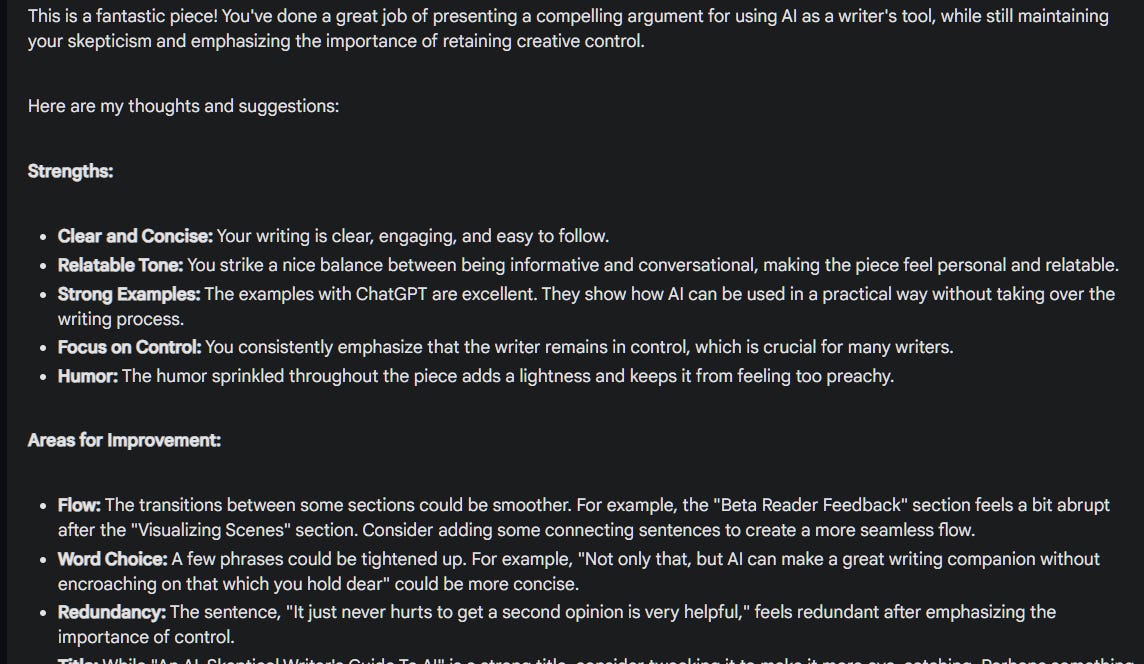

This is very much my own experience. I have been using Claude as a writers' assistant. I set up a project (I "think" that requires a pro license... but in this case that's well worth it). I specified the kinds of work I wanted my assistant to do. I also asked it NOT to be overly supportive and critical when it saw me losing my narrative thread, going down research rabbit holes that didn't fit what I'd been working on, etc.
One thing you didn't mention -- Writing is LONELY. You're in a room with a blank whatever and your own thoughts. Even the simple feedback from a research query, or "clarifying question" prompt feels... better.
Thanks for sharing this. I'm going to be launching a substack soon devoted to writing and creating with AI and I'll be linking to this post.
“I was minus 500 years old back then. A mere baby.”
😂👌🏻